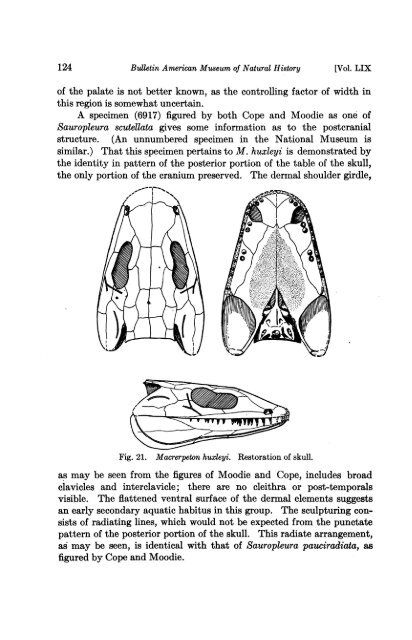View/Open - American Museum of Natural History
View/Open - American Museum of Natural History
View/Open - American Museum of Natural History
Create successful ePaper yourself
Turn your PDF publications into a flip-book with our unique Google optimized e-Paper software.
124 Bulletin <strong>American</strong> <strong>Museum</strong> <strong>of</strong> <strong>Natural</strong> <strong>History</strong><br />
[Vol. LIX<br />
<strong>of</strong> the palate is not better known, as the controlling factor <strong>of</strong> width in<br />
this regiol is somewhat uncertain.<br />
A specimen (6917) figured by both Cope and Moodie as one <strong>of</strong><br />
Sauropleura scutellata gives some information as to the postcranial<br />
structure. (An unnumbered specimen in the National <strong>Museum</strong> is<br />
similar.) That this specimen pertains to M. huxleyi is demonstrated by<br />
the identity in pattern <strong>of</strong> the posterior portion <strong>of</strong> the table <strong>of</strong> the skull,<br />
the only portion <strong>of</strong> the cranium preserved. The dermal shoulder girdle,<br />
Fig. 21. Macrerpeton huxleyi. Restoration <strong>of</strong> skull.<br />
as may be seen from the figures <strong>of</strong> Moodie and Cope, includes broad<br />
clavicles and interclavicle; there are no cleithra or post-temporals<br />
visible. The flattened ventral surface <strong>of</strong> the dermal elements suggests<br />
an early secondary aquatic habitus in this group. The sculpturing consists<br />
<strong>of</strong> radiating lines, which would not be expected from the punctate<br />
pattern <strong>of</strong> the posterior portion <strong>of</strong> the skull. This radiate arrangement,<br />
as may be seen, is identical with that <strong>of</strong> Sauropleura pauciradiata, as<br />
figured by Cope and Moodie.
















